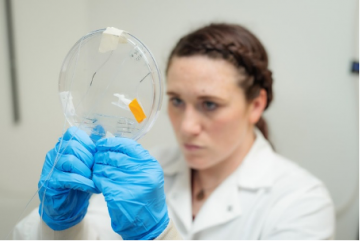 In this interview, we speak with Tanya Bennet, from the UBC New Frontiers in Research Fund project, Mend the Gap. Tanya is a PhD candidate in the in vitro testing team led by Dr. Karen Cheung.
In this interview, we speak with Tanya Bennet, from the UBC New Frontiers in Research Fund project, Mend the Gap. Tanya is a PhD candidate in the in vitro testing team led by Dr. Karen Cheung.
by Adam Fraser, Head of Research Operations, Mend the Gap
Tell us about yourself!
I am a PhD candidate in Biomedical Engineering, working in Professor Karen Cheung’s group. I transferred to the PhD program from the Master of Applied Science program in Biomedical Engineering at UBC. My Bachelor’s degree in Integrated Engineering is also from UBC, with a focus on Bioprocessing and Biomaterials. My role in Mend the Gap is to develop the in vitro platforms that will be used to test candidate biomaterials before they advance to pre-clinical testing at the International Collaboration for Repair Discoveries (ICORD). I currently work in the Life Sciences Institute at UBC.
What is your area of research in Mend the Gap?
My area of focus is the development of in vitro models, specifically an injury model for testing biomaterials for neural regrowth, which models a spinal cord lesion site. The research involves looking at what is available in terms of in vivo data for humans and thinking, “How do we translate this information into a simplified model that can be used for high-throughput screening of biomaterials?”. Over the past year, we have developed an injury microdevice, where we allow cells to grow in an environment similar to that seen in vivo, and then create a reproducible mock injury, and add our candidate biomaterials into the “injury” space. We then use microscopy in 2D and 3D to see what’s happening. Essentially, we’ve created an advanced petri dish that allows us to mimic a spinal cord lesion. Our goal with the model is to evaluate how the neural cells respond to the biomaterials before taking the materials to the next step of in vivo testing. This saves us a lot of time and effort by pre-screening the materials before they go to more advanced testing.
What is the biggest practical challenge in your work?
Our bodies are built to interact with the macroscale, so any time you’re dealing with something very small, there can be challenges. Our model is on the mesoscale, where it’s not easy to see the main components with your eyes, but also a microscope is not absolutely needed. This allows us to handle the components, but it’s very difficult. We use explants, which are little tissues that you can see as a spec in the microdevice. We can even see these specs growing over time. When we use dissociated cells it’s relatively easy, because you can create a cell suspension and pipetting is like using a liquid. But with explants, we have to isolate the tiny little specs of tissue and place them correctly in the device. We’ve had to develop creative protocols that allow us to do this consistently, and standardizing those processes is challenging. However, the design of the model itself helps us, and one nice thing is that the model has an open window that is compatible with microscopy, so we can look in real-time and see what the cells are doing. It’s really interesting to watch the bundles of cells growing and see what happens when they come into contact with the biomaterials.
What is your biggest academic challenge?
Before Mend the Gap, I wasn’t familiar with neurobiology. Coming from an engineering background that specialized in the mechanical and materials side, it took me a while to be able to look at a microscopy image of neural cells and understand what was happening. But on the other hand, it’s been a great opportunity to learn collaboratively with biologists, who may immediately understand an image, but when they interact with the microdevice it’s foreign to them. That is why it is so important for us all to be in the lab together at the same time having these conversations, because we speak different languages and things that are easy for me are challenges for them, and vice versa. I’ve learned a lot from the people I work with on Mend the Gap.
How will Mend the Gap play a role in your future career?
Mend the Gap is so intriguing to me because it’s a validated clinical need with so much supporting work that’s been done with persons with lived experience. I hope to see the project go through in vivo testing and onto clinical stages, to see something go from ideation to implementation. My next goal is to do a postdoctoral fellowship at UBC, in collaboration with the team at Praxis Spinal Cord Institute in Vancouver, and with the community they foster around spinal cord injury care and research. Knowing the people who these new technologies will affect has been hugely important to me. As a competitive rugby player, I have friends who, while playing a sport they love, experienced a spinal cord injury, and I would like to play a role in bringing clinicians and researchers together to identify problems and come up with innovative solutions. My passion is to learn more about the pipelines that exist to take something from bench-top to bed-side, and initiating conversations to solve real-world problems.